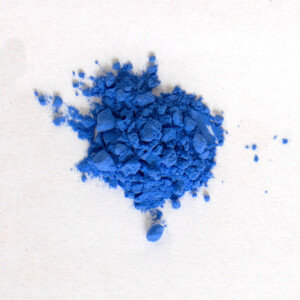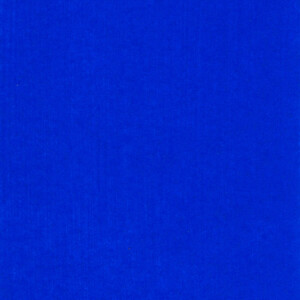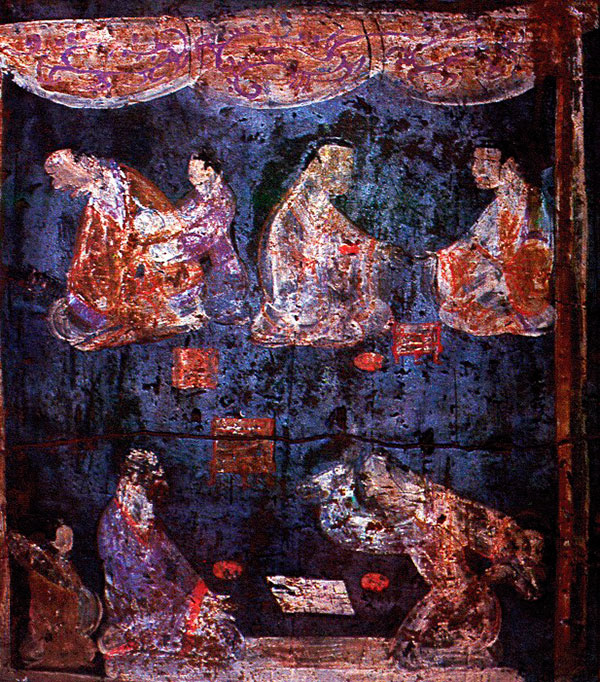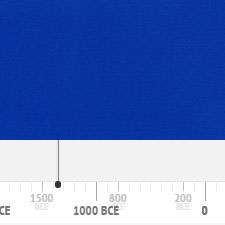Han Blue
Synthetic inorganic pigmentComposition and Properties of Han Blue
Han blue is a synthetic barium copper silicate with the chemical formula BaCuSi2O6. It is similar in composition, properties, and color to Egyptian blue (CaCuSi4O10). Recently, it has been discovered that it occurs naturally as the rare mineral Effenbergerite.
The stability of this pigment is high and it is also resistant to high temperatures and it is lightfast as well.

Pigment

Painted swatch

Mineral Effenbergerite. Image (c) RRUFF Database
Names
Alternative names
Chinese blue
Word origin
Named after the Han Dynasty of Chinese emperors, the second imperial dynasty (206 B.C. until 220 AD).
Han-Blau
German
Han-bleu
French
Azzurro Han
Italian
azul Han
Spanish
Preparation of Han Blue
The pigment can be prepared by heating a mixture of either witherite (BaCO3) or barite (BaSO4), malachite (Cu2(CO3)(OH)2) and quartz (SiO2) in the presence of a lead salt (carbonate or oxide) to about 1000 °C. The lead salts serve as a catalyst for the chemical reaction and also facilitate the melting of the raw materials.
References
(1) Wiedemann, H. G. Bayer, G. and Reller, A. 1998. Egyptian blue and Chinese blue. Production technologies and applications of two historically important blue pigments. In: S. Colinart and M. Menu (eds.) La couleur dans la peinture et l’émaillage de l’Égypte ancienne. Actes de la Table Ronde Ravello, 20–22 mars 1997. Bari: Edipuglia, 195–203.
(2) Berke, H.; Wiedemann, H. G. (2000). “The Chemistry and Fabrication of the Anthropogenic Pigments Chinese Blue and Purple in Ancient China“. East Asian Science, Technology and Medicine (EASTM). 17: 94–120.
History of Use
Han blue was used in ancient and imperial China from the Western Zhou period (1045–771 BC) until the end of the Han dynasty (circa 220 AD).
References
(1) Berke, H. Chemistry in Ancient Times: The Development of Blue and Purple Pigments. Angewandte Chemie International Edition 41/14, 2483–2487, 2002.
(2) Berke, Heinz (2007). “The Invention of Blue and Purple Pigments in Ancient Times”. ChemInform. 38 (19). doi:10.1002/chin.200719227
Examples of use
Detail of a mural from an Eastern Han tomb near Luoyang, Henan showing a pair of Liubo players, containing both Han blue and Han purple pigments, 25-220 AD

Identification
Visible and NIR Spectra
Visible and NIR reflectance and fluorescence spectra of Han blue can be found at the website of Bob Fosbury.
References
(1) Cheng, Xiaolin; Xia, Yin; Ma, Yanru; Lei, Yong (2007). “Three fabricated pigments (Han purple, indigo and emerald green) in ancient Chinese artifacts studied by Raman microscopy, energy-dispersive X-ray spectrometry and polarized light microscopy”. Journal of Raman Spectroscopy. 38 (10): 1274. doi:10.1002/jrs.1766
(2) Zuo, Jian; Zhao, Xichen; Wu, Ruo; Du, Guangfen; Xu, Cunyi; Wang, Changsui (2003). “Analysis of the pigments on painted pottery figurines from the Han Dynasty’s Yangling Tombs by Raman microscopy”. Journal of Raman Spectroscopy. 34 (2): 121. doi:10.1002/jrs.963
(3) Verri G, The spatially resolved characterization of Egyptian blue, Han blue and Han purple by photo-induced luminescence digital imaging. Anal Bioanal Chem. 2009 Jun;394(4):1011-21. doi: 10.1007/s00216-009-2693-0. Epub 2009 Feb 21
Further Reading
References
(1) FitzHugh, E. W. and Zycherman, L. A. An Early Man-Made Blue Pigment from China: Barium Copper Silicate. Studies in Conservation 28/1, 1983, 15–23.
(2) Berke, Heinz (2007). “The Invention of Blue and Purple Pigments in Ancient Times”. ChemInform. 38 (19). doi:10.1002/chin.200719227
(3) Berke, H. Chemistry in Ancient Times: The Development of Blue and Purple Pigments. Angewandte Chemie International Edition 41/14, 2483–2487, 2002.
(4) Berke, H.; Wiedemann, H. G. (2000). “The Chemistry and Fabrication of the Anthropogenic Pigments Chinese Blue and Purple in Ancient China“. East Asian Science, Technology and Medicine (EASTM). 17: 94–120.
(5) Wiedemann, H. G. and Bayer, G. 1997. Formation and Stability of Chinese Barium Copper-Silicate Pigments. In: N. Agnew (ed.) Conservation of Ancient Sites on the Silk Road: Proceedings of an International Conference on the Conservation of Grotto sites. Los Angeles: The Getty Conservation Institute, 379–387.
(6) François Delamare, Blue Pigments: 5000 years of Art and Industry, Archetype Publications, 2013.
(7) S. Muntwyler, J. Lipscher, HP. Schneider, Das Farbenbuch, 2nd. Ed., 2023, alataverlag Elsau, pp. 74-75.

